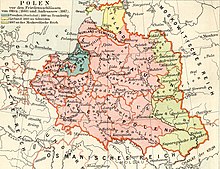Greater Poland

The landscape of Greater Poland ( Polonia maior ) or Wielkopolska forms the historical core of Poland and describes the oldest part of Poland around Poznan and Gniezno .
history
Polonia maior , from which the term Greater Poland is derived, was the name of the settlement area of the Polans , the Slavic tribe, in the 9th and 10th centuries , whose princes, the Piasts , founded the first Polish kingdom and the first kings of Poland at the end of the 10th century posed. The first capital of this kingdom was Gnesen, Poland .
After the division of the inheritance of the Kingdom of Poland in 1138 in duchies which was created Duke of Greater Poland . In 1320, the duchy was dissolved as a feudal rulership and divided into two voivodships : one based in Poznań , the other in Kalisz (Palatinatus Posnaniensis and Palatinatus Calisiensis). From then on, the voivodships were among the most important administrative regions of the United Kingdom of Poland.
After the establishment of the First Polish Republic in 1569, a large province called Greater Poland was created which, in addition to the eponymous landscape, also included Mazovia and Royal Prussia .
With the second partition of Poland in 1793, Greater Poland fell to Prussia and formed the province of South Prussia until the Peace of Tilsit in 1807 . To 1815 part of the Duchy of Warsaw , the western part was at the Congress of Vienna, the Prussian Kingdom as Posen struck and the eastern to the newly created Kingdom of Poland , which after the November Uprising in 1830 from the Russian Empire , first to a satellite state and from 1876 to the province Weichselland disempowered and from 1916 under the rule of the Central Powers as the reigning kingdom of Poland was re-established.
After the Poznan Uprising (1918-1919) and the Treaty of Versailles , Greater Poland belonged to the Second Polish Republic until the invasion of Poland ushered in the German occupation of Poland from 1939 to 1945 . In October 1939, the military district of Posen was annexed by the German Reich in violation of international law , not as a new province in the Free State of Prussia , but within its previous borders as the new Reichsgau Posen with administrative headquarters in Posen, which was renamed Reichsgau Wartheland in January 1940 . Captured by the Red Army in the Vistula-Oder operation in January 1945 , Greater Poland became part of the People's Republic of Poland , the predecessor of today's Third Polish Republic, with the implementation of the Potsdam Agreement .
Name and meaning
The German term “Großpolen” is somewhat misleading, as it suggests a large area encompassing all Polish settlement areas in the sense of irredentism (cf. Greater Serbia , Greater Germany ). Compared to other parts of Poland , the region is rather medium-sized, for example compared to Lesser Poland , which at least in earlier times comprised a much larger area. In fact, the terms Polonia maior and Polonia minor , which appeared in the Polish Latin chancellery language in the 11th century - which were later translated as Wielkopolska and Malopolska ("Greater Poland" and "Lesser Poland") - have nothing to do with territorial expansion. Rather, what was meant was a distinction between maior and minor in the sense of "older" and "younger", because Polonia minor (actually "Young Poland") around Kraków (Cracow) was not joined to the Polish kingdom until the end of the 10th century had only included Polonia maior ("Old Poland") around Gniezno (Gnesen).
geography
Greater Poland includes today's Greater Poland Voivodeship as well as the southern part (Kujawien) of the Kuyavian-Pomeranian Voivodeship and the eastern strip of the Lubusz Voivodeship . Wielkopolska was home to Gniezno (Gnesen) and Posen (Poznań), the country's two earliest capitals, until Kraków (Kraków) became the capital of Poland in 1038 under Casimir I the innovator .
present
Today Greater Poland, together with Mazovia, forms the central parts of the country, through which the important traffic axes run in an east-west direction. The most important rivers are the Oder (Odra) , the Warta (Warta) and the Vistula (Wisła) , the most important cities are Poznań (Poznan) and Gniezno (Gnesen) , Kalisz (Kalisch) and Leszno (Lissa).
